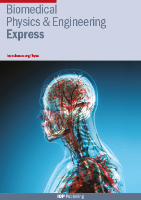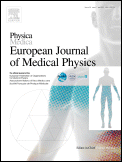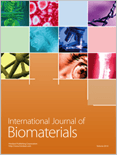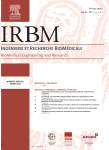
Biomedical Physics & Engineering Express
Scope & Guideline
Exploring the Future of Biophysics and Patient Care
Introduction
Aims and Scopes
- Medical Imaging and Image Processing:
Research in this area includes the development and optimization of imaging techniques such as MRI, CT, and PET, focusing on improving image quality, diagnostic accuracy, and computational methods for image analysis. - Radiation Therapy and Dosimetry:
The journal covers innovative techniques in radiation therapy, including dosimetric evaluations, treatment planning, and the use of advanced technologies such as Monte Carlo simulations to improve patient outcomes. - Biomaterials and Tissue Engineering:
Research on the design and application of biomaterials, including 3D printing and bioprinting techniques, aimed at developing scaffolds and devices for tissue regeneration and repair. - Artificial Intelligence and Machine Learning Applications:
The journal highlights the integration of AI and machine learning methods in medical imaging, diagnostics, and treatment planning, showcasing innovative approaches for enhancing clinical decision-making. - Bioelectronics and Biomedical Sensors:
Focus on the development of sensors and devices for monitoring physiological signals, including advancements in electrical impedance tomography and wearable technologies. - Nanotechnology in Medicine:
Research covering the application of nanomaterials and nanoparticles in drug delivery, imaging, and therapeutic interventions, with a focus on their biological interactions and efficacy.
Trending and Emerging
- Integration of AI in Medical Imaging:
There is a significant increase in research focusing on the application of artificial intelligence and machine learning algorithms in medical imaging, aimed at automating processes such as image segmentation, classification, and enhancement, thus improving diagnostic accuracy. - Personalized Medicine and Treatment Planning:
An emerging trend is the focus on personalized medicine, including patient-specific treatment planning through advanced modeling techniques and the use of AI to tailor therapies based on individual patient characteristics. - Wearable and Remote Health Monitoring Technologies:
Research is increasingly directed towards the development of wearable devices and remote monitoring technologies that allow for continuous health tracking and management, emphasizing the importance of real-time data in patient care. - Nanotechnology and Targeted Drug Delivery:
The application of nanotechnology for targeted drug delivery systems is gaining momentum, highlighting its potential to improve therapeutic efficacy and reduce side effects in cancer treatment and other medical applications. - 3D Printing in Healthcare:
The use of 3D printing technologies for creating customized medical devices, prosthetics, and tissue scaffolds is on the rise, reflecting a growing interest in personalized solutions for patient care.
Declining or Waning
- Traditional Dosimetry Techniques:
As more advanced computational and simulation-based dosimetry methods gain traction, traditional dosimetry techniques are seeing less emphasis in recent publications, potentially due to the push for more accurate and efficient alternatives. - Basic Research in Electrophysiology:
Although still relevant, the focus on basic electrophysiological studies has diminished, possibly overshadowed by more applied research that integrates electrophysiological principles into clinical practices and technologies. - Conventional Imaging Techniques:
With the rapid advancement of AI and machine learning applications, traditional imaging techniques without computational enhancements may be receiving less attention, as researchers shift towards innovative methodologies that improve diagnostic capabilities.
Similar Journals

Physica Medica-European Journal of Medical Physics
Transforming Medical Physics Through Collaborative ResearchPhysica Medica - European Journal of Medical Physics is a premier peer-reviewed journal published by ELSEVIER SCI LTD, dedicated to advancing the field of medical physics. Established in 1989 and serving as a critical platform for innovative research, this journal covers a broad spectrum of topics within biophysics, radiology, and imaging sciences, consistently ranked in the Q1 category across these disciplines. With an impressive impact factor that highlights its influence within the scientific community—ranking 52/333 in Radiology, 42/243 in Physics and Astronomy, and 35/152 in Biochemistry—the journal is a valuable resource for professionals, researchers, and students aiming to contribute to the technological and methodological advancements in medical physics. Physica Medica is committed to fostering open dialogue and collaboration within the global medical physics community, although it currently does not offer open access options. The journal's extensive citation history and ongoing relevance underscore its importance in the continuous evolution of medical science.

VIEW
Transforming Ideas into Innovations in Biomaterials Science.VIEW is a prestigious journal published by WILEY that focuses on the rapidly evolving fields of Biomaterials and Biomedical Engineering. Since its inception in 2020, VIEW has established itself as an open-access platform dedicated to disseminating high-quality research and innovation within these disciplines. With an impressive impact factor that places it in the Q1 category of both Biomaterials and Biomedical Engineering, VIEW ranks among the top journals in its field, boasting a 91st percentile ranking in Biomedical Engineering and an 85th percentile ranking in Materials Science. Researchers, professionals, and students are encouraged to utilize this invaluable resource, as it provides a comprehensive view of current advancements and future trends in biomaterial science and engineering. Positioned in the United Kingdom, VIEW operates as a vital scholarly communication link, fostering collaboration and knowledge sharing within an ever-growing global community.

Progress in Biomedical Engineering
To elevate biomedical solutions for a healthier tomorrow.Progress in Biomedical Engineering, published by IOP Publishing Ltd, is a premier open-access journal that serves as a vital platform for the dissemination of innovative research in the field of biomedical engineering. With an impressive Q1 classification in the Biomedical Engineering category for 2023, this journal has established itself as a significant contributor to the advancement of engineering solutions that improve healthcare outcomes. Recognized for its high-quality and impactful publications, it ranks 51st out of 303 in its field on Scopus, placing it in the 83rd percentile. The journal aims to foster interdisciplinary collaboration and introduce pioneering methodologies and technologies that bridge the gap between engineering and medicine. By providing a pathway for rapid communication of fundamental and applied research, Progress in Biomedical Engineering is dedicated to shaping the future of healthcare technology. Access to its content ensures that researchers, professionals, and students remain at the forefront of biomedical innovation.

PHYSICS IN MEDICINE AND BIOLOGY
Unveiling New Horizons in Medical Physics and BiologyPHYSICS IN MEDICINE AND BIOLOGY is a prestigious journal published by IOP Publishing Ltd, with a storied history dating back to 1956 and extending through 2024. This internationally recognized journal caters to the interdisciplinary fields of medical physics and bioengineering, making significant contributions to the research and development of advanced diagnostic and therapeutic technologies. It holds an impressive Q1 ranking in both Radiological and Ultrasound Technology and Radiology, Nuclear Medicine and Imaging categories, reflecting its critical role in disseminating high-quality research. With a significant focus on merging the principles of physics with advancements in medicine, PHYSICS IN MEDICINE AND BIOLOGY serves as an essential resource for researchers, professionals, and students alike, fostering innovation and enhancing collaboration in the healthcare sector. Although the journal is not currently open access, it maintains robust participation in the Scopus database, ranking #62 out of 333 in Radiology, Nuclear Medicine and Imaging and #17 out of 63 in Radiological and Ultrasound Technology, signifying its influence and reach within these disciplines.

Physical and Engineering Sciences in Medicine
Exploring New Frontiers in Health TechnologiesPhysical and Engineering Sciences in Medicine is an esteemed peer-reviewed journal published by SPRINGER, dedicated to advancing the interdisciplinary fields of biomedical engineering and biophysics. With an ISSN of 2662-4729 and an E-ISSN of 2662-4737, this journal has carved a niche for itself since its inception in 2020. Situated in the Netherlands, it serves as a global platform for innovative research and developments that bridge the physical sciences and engineering with medical applications. The journal boasts a commendable range of quartile categorizations, highlighting its impact in various sectors including Instrumentation (Q1), Radiology (Q2), and Biotechnology (Q2). Its Scopus rankings further emphasize its relevance and quality, placing it in the top 15% in several categories. Being an Open Access title, it promotes the dissemination of knowledge, ensuring that vital research is accessible to all, thereby fostering collaboration among researchers, professionals, and students alike. The journal's objectives include promoting cutting-edge research, enhancing biomedical technology, and addressing complex health challenges through innovative engineering solutions, establishing it as a vital resource in the scientific community.

BME Frontiers
Pioneering Insights for Tomorrow's Medical TechnologiesBME Frontiers, published by the American Association for the Advancement of Science, is an innovative open-access journal dedicated to the burgeoning field of Biomedical Engineering. Since its establishment in 2020, this journal has aimed to bridge the gap between cutting-edge research and practical application, promoting advancements in biomedical technologies, medical devices, and healthcare solutions. Boasting impressive rankings within Scopus—64th among 398 in Medicine (miscellaneous) and 81st among 303 in Biomedical Engineering—BME Frontiers stands out as a significant contributor to scholarly communication, offering rich insights for researchers, professionals, and students alike. With consistent publication projected through 2024, the journal serves as an essential platform for disseminating high-quality research that can drive innovation and inspire new approaches in the healthcare sector.

ANNALS OF BIOMEDICAL ENGINEERING
Transforming biomedical challenges into engineering solutions.ANNALS OF BIOMEDICAL ENGINEERING is a premier journal in the field of biomedical engineering, published by Springer. Established in 1972, this journal has become a vital resource for researchers, professionals, and students engaged in the rapidly evolving domain of biomedical technology. With a commendable impact factor and ranked in the 76th percentile among its peers as per Scopus, it exemplifies excellence in disseminating critical research findings. The journal covers a broad scope of topics related to the integration of engineering principles with medical and biological sciences, facilitating innovations that enhance healthcare outcomes. Although open access is not offered in this journal, it remains an essential platform for scholarly communication, contributing to the continuous advancement of knowledge in biomedical engineering. ANNALS OF BIOMEDICAL ENGINEERING is not only a bridge for academics to share groundbreaking research but also an influential guide for practical applications in medicine and health technologies, making it a fundamental publication for its readership.

International Journal of Biomaterials
Transforming patient outcomes with pioneering biomaterials insights.The International Journal of Biomaterials, published by HINDAWI LTD, is a premier platform for disseminating groundbreaking research in the fields of biomaterials and biomedical engineering. With an Open Access approach since 2009, this journal provides unhindered access to innovative studies and applications aimed at advancing medical technologies and improving patient outcomes. Notably ranked in the Q3 category for both Biomaterials and Biomedical Engineering in 2023, it serves as an essential resource for researchers, practitioners, and students alike. The journal's Scopus rankings, including a 49th percentile in Biomedical Engineering and a 40th percentile in Biomaterials, further underscore its growing prominence in the academic community. With contributions spanning from 2011 to 2024, the journal seeks to foster collaborative research and promote developments that enhance the understanding and application of biomaterials in healthcare.

IRBM
Catalyzing Transformative Ideas in Life Sciences ResearchIRBM, published by Elsevier Science Inc, stands at the forefront of research in the domains of Biomedical Engineering and Biophysics, boasting impressively high rankings with a Q1 category in both fields according to the 2023 evaluations. With an effective focus on cutting-edge innovations and methodologies, IRBM provides a vital platform for researchers, professionals, and students alike seeking to disseminate and access groundbreaking findings and developments. Its strong presence in the Scopus database, with ranks of #12 in Biochemistry, Genetics and Molecular Biology and #42 in Biomedical Engineering, places it in the top percentile of impactful journals in the field, making it a crucial resource for advancing knowledge and fostering collaboration. While the journal maintains a traditional subscription model, it continues to attract a diverse readership eager for insightful studies and reviews that push the boundaries of science and engineering. With a projected convergence of years extending to 2024, IRBM promises to remain a significant contributor to the ongoing dialogue in the life sciences.

Bioactive Materials
Fostering Collaboration in Cutting-edge Biomedicine ResearchBioactive Materials, published by KEAI PUBLISHING LTD, stands as a leading Open Access journal in the fields of Biomaterials, Biomedical Engineering, and Biotechnology. Since its inception in 2016, this journal has rapidly ascended in prominence, currently holding a prestigious Q1 category ranking across multiple disciplines, reflecting its significant impact within the scientific community. With its E-ISSN 2452-199X, it spans a broad spectrum of research areas, contributing valuable insights to the ongoing discourse in bioactive materials and their applications. The journal's superior Scopus rankings further illustrate its influence, boasting impressive standings in engaging niches such as engineering and molecular biology. Bioactive Materials offers a vital platform for researchers, professionals, and students to disseminate and acquire cutting-edge knowledge, thus fostering innovation and collaboration in the rapidly evolving terrain of biomedicine. Its commitment to Open Access since 2016 enhances accessibility, ensuring that the burgeoning advancements in this field reach a global audience.